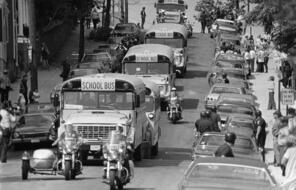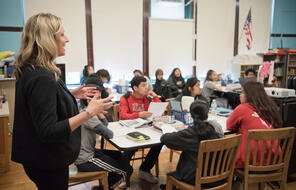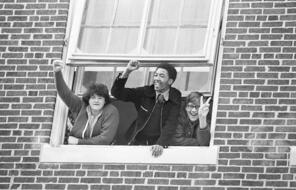White Opposition to the Desegregation Order (en español)
In 1974 and 1975, in many parts of Boston, students of different races and ethnicities began to attend school together for the first time with few problems. The fiercest opposition to Judge Garrity’s desegregation order came from three poor and working-class white neighborhoods: South Boston, East Boston, and Charlestown. Judge Garrity’s desegregation plan assigned Black students from Roxbury to South Boston High School and white students from South Boston to Roxbury High School. South Boston and Roxbury were the two neighborhoods in Boston with the highest percentage of low-income families.
Michael Patrick MacDonald was an elementary school student in South Boston that year. In his memoir, he describes how his neighbors talked about the desegregation busing plan:
Some said it was the communists who were making this happen. Still others said it was rich lawyers, judges, and politicians from the suburbs, and that it had nothing to do with the blacks, that they didn’t want to come to Southie any more than we wanted to go to Roxbury. In the end it didn’t really matter who we were united against, as long as we kept up our Southie loyalty. 1
While many of his neighbors said racist things about the students who would be bused from Roxbury to South Boston, MacDonald writes:
Others were starting to talk about how this wasn’t about race. That it was about poor people being told that they have to do things that rich people don’t have to do. Our mothers couldn’t get over people thinking that we had something in our schools that blacks in Roxbury didn't have. “Our kids have just as little,” they said. “Neither side has a pot to piss in and now they want us to fight over who can piss in what alley.” 2
All three neighborhoods—South Boston, East Boston, and Charlestown—were divided by geography from the rest of the city. Before 1974, the Boston School Committee forced as many as 30,000 students to travel to schools outside of their own neighborhoods in order to keep the schools segregated. But because of the geographic separation, these three neighborhoods were the only ones in the city whose children had never been asked to attend schools outside of their neighborhoods before. Therefore, in addition to the race and class resentment many felt, these Bostonians were losing a sense of control over the schools in their own neighborhoods. 3
South Boston was the only neighborhood of the three to be included in the desegregation plan for the 1974–75 school year. Charlestown and East Boston would be included the following year. In 1974, a new community group named ROAR (Restore Our Alienated Rights) was formed by Louise Day Hicks, a Boston city councilor and former school committee member, to oppose the desegregation plan. ROAR organized a boycott by white students at the beginning of the school year. Only 68 of the 750 white students at South Boston High School attended school on the first day. Across the city, 25,000 white students joined the boycott (about one-fourth of all of the students in the school system). 4
The Black students who arrived on buses at South Boston High School on the first day of school in 1974 were greeted by a crowd of hundreds of South Boston residents who were booing, taunting, and yelling insults and racial slurs. In the afternoon, violence erupted. MacDonald, who stayed out of school that day and was on the street, recalls:
Smash! A burst of flying glass and all that rage exploded. We’d all been waiting for it, and so had the police in riot gear. It felt like a gunshot, but it was a brick. It went right through a bus window. Then all hell broke loose. I saw a milk crate fly from the other side of the street right for my face. More bricks, sticks, and bottles smashed against the buses, as police pulled out their billy clubs and charged with their riot shields in a line formation through the crowds. Teenagers were chased into the (housing) project and beaten to the cement wherever they were caught. 5
Historian Jim Vrabel writes: “The buses carrying Black students there were pelted with eggs, rocks, and bottles. Eight of the students and an adult bus monitor were injured in what was the first—but wouldn’t be the last—busing-related violence.” 6
- 1Michael Patrick MacDonald, All Souls: A Family Story from Southie (Boston: Beacon Press, 1999), 76.
- 2MacDonald, All Souls, 76.
- 3Jim Vrabel, A People’s History of the New Boston (Amherst and Boston: University of Massachusetts Press, 2014), 178.
- 4Vrabel, A People’s History of the New Boston, 179.
- 5MacDonald, All Souls, 83.
- 6Vrabel, A People’s History of the New Boston, 179.













